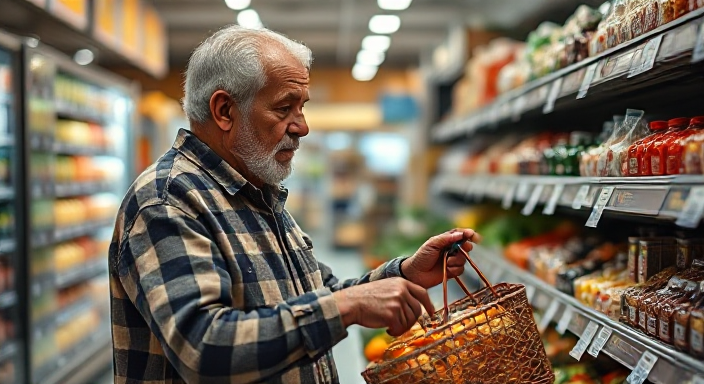

Healthy Food Inflation: Why Nourishing Your Body Costs More Than Ever


Arya Soleil
“I don’t wanna party like it’s 1999… I wanna buy avocados like they’re 50 cents again.” This playful sentiment might get a chuckle, but beneath it lies a serious issue—why is healthy food so expensive? From avocados to leafy greens, nutrient-dense, whole foods have become symbols of privilege rather than staples for everyone.
Inflated costs for fresh, healthy options reflect a deeper problem within our global food system. While fast food and processed snacks are cheap and ubiquitous, fresh fruits, vegetables, and other wholesome choices often feel like luxury items. Let’s explore why healthy food is becoming harder to afford, who is affected, and what can be done to ensure everyone has access to nourishing, whole foods.
The High Price of Health: Why is Fresh Food So Expensive?
The inflated cost of healthy food isn’t just a coincidence—it’s the result of complex economic, agricultural, and systemic factors. Here’s why your grocery bill for fresh produce keeps climbing:
Supply and Demand Disparities
As more people embrace wellness trends and seek out nutrient-rich foods like avocados, kale, and berries, demand surges. But these foods require specific growing conditions and often can’t be mass-produced at the same scale as processed foods. Supply struggles to keep up, driving prices higher.Labor-Intensive Production
Farming fresh produce requires significant labor—from planting and harvesting to sorting and packaging. Many of these tasks can’t be mechanized, unlike the production of processed foods. Add fair wages and labor shortages to the equation, and production costs soar, passing the burden onto consumers.Climate Change and Unpredictable Weather
Erratic weather patterns, droughts, and other climate challenges have wreaked havoc on crops worldwide. For example, avocados rely on specific weather conditions, and a single bad growing season can shrink supply, pushing prices sky-high.Transportation and Globalization
Healthy foods like bananas, avocados, and quinoa often travel thousands of miles before reaching your plate. Rising fuel prices and logistical challenges further inflate their cost. Locally grown produce isn’t always a cheaper option either, as small-scale farms face their own financial hurdles.Government Subsidies for Processed Foods
Here’s the kicker—many governments heavily subsidize crops like corn, soy, and wheat, which are used to produce cheap processed foods. Meanwhile, fruits, vegetables, and other whole foods rarely receive the same support, making them more expensive by comparison.
Who Pays the Price?
The inflation of healthy food affects everyone, but it hits some communities much harder than others:
- Low-Income Families: Families on tight budgets often prioritize caloric quantity over nutritional quality because processed foods are cheaper and more filling. This perpetuates cycles of poor health and diet-related diseases.
- Food Deserts: In areas with limited access to grocery stores, fresh produce is scarce, and residents are left with overpriced, low-quality options or fast food.
- Health-Conscious Consumers: Even those willing to invest in healthier options feel the pinch, as the price gap between processed and fresh foods grows wider.
Ultimately, the rising cost of healthy food isn’t just an economic issue—it’s a public health crisis.
The Real Cost of Cheap, Processed Food
While processed foods may seem like a bargain, they come with hidden costs:
- Health Costs: Diets high in processed foods contribute to obesity, diabetes, heart disease, and other chronic illnesses. The medical expenses associated with these conditions far outweigh the savings at the checkout counter.
- Environmental Costs: Producing cheap, processed food often relies on industrial farming practices that deplete soil, pollute water sources, and contribute to greenhouse gas emissions.
- Social Costs: The over-reliance on subsidies for processed food crops leaves small farmers struggling to compete and limits access to diverse, nutrient-dense crops.
What Can Be Done to Make Healthy Food Affordable?
Fixing the problem of healthy food inflation requires a collective effort from governments, food producers, and consumers. Here’s how we can push for change:
Advocate for Subsidy Reform
Governments need to shift subsidies toward fruits, vegetables, and other nutrient-dense crops. By leveling the playing field, we can make healthy options more affordable and accessible.Support Local Agriculture
Buying from local farmers reduces transportation costs and supports smaller-scale, sustainable farming practices. Farmers’ markets, community-supported agriculture (CSA) programs, and urban gardens are great ways to prioritize local produce.Reduce Food Waste
Nearly one-third of all food produced globally is wasted. By buying only what we need, storing food properly, and getting creative with leftovers, we can reduce demand and keep prices down.Embrace Home Gardening
Growing your own food is one of the most cost-effective ways to enjoy fresh produce. Even a small herb garden or a few pots of tomatoes on a balcony can make a difference.Shop Seasonally
Seasonal produce is often cheaper and fresher than out-of-season options. Learning to cook with what’s in season can save money and elevate your meals.
A Call for Food Justice
The inflated cost of healthy food underscores a larger issue: access to nourishing, whole foods is a human right, not a privilege. Everyone deserves the opportunity to eat well, feel good, and thrive.
We need to challenge the systems that prioritize profits over public health. This means pushing for policies that support sustainable farming, fair wages for agricultural workers, and equitable access to fresh food for all communities.
The Takeaway: Beyond the Avocado
When we long for 50-cent avocados, we’re really longing for a food system that values health, sustainability, and community over convenience and profit. While it may feel frustrating to watch the cost of healthy foods rise, we can take small but meaningful steps to make a difference.
From supporting local farmers to growing our own produce, every choice we make as consumers sends a message. And when enough of us demand change, we can shift the system toward one that makes healthy eating accessible for everyone.
So let’s dream of a world where nourishing food isn’t a luxury—where avocados are affordable, fresh produce is abundant, and health is a choice available to all. It may not happen overnight, but with every step we take, we get closer to a healthier, more equitable food system.
Recommended Reads

- December 29, 2024
Check out 7 truths and myths about diet
Have you ever heard of some diet myths that...


- December 29, 2024
Is fasting really a good option? Check out the precautions of this eating style
Living in a society that is based on a...


- December 29, 2024
Start having healthy habits with these 7 benefits of a balanced diet!
If you want to live a quality life, you...


- December 29, 2024
Check out the list of 54 anti-inflammatory foods for your diet!
A balanced diet ensures all the nutrients possible for a routine...


- December 29, 2024
Find out how to cut back on sugar in your diet!
It’s very likely that at some point in your...


- December 29, 2024
What are the benefits of each vitamin in your body?
If your goal is to have a healthy routine and...

Healthy Food Inflation: Why Nourishing Your Body Costs More Than Ever

“I don’t wanna party like it’s 1999… I wanna buy avocados like they’re 50 cents again.” This playful sentiment might get a chuckle, but beneath it lies a serious issue—why is healthy food so expensive? From avocados to leafy greens, nutrient-dense, whole foods have become symbols of privilege rather than staples for everyone.
Inflated costs for fresh, healthy options reflect a deeper problem within our global food system. While fast food and processed snacks are cheap and ubiquitous, fresh fruits, vegetables, and other wholesome choices often feel like luxury items. Let’s explore why healthy food is becoming harder to afford, who is affected, and what can be done to ensure everyone has access to nourishing, whole foods.
The High Price of Health: Why is Fresh Food So Expensive?
The inflated cost of healthy food isn’t just a coincidence—it’s the result of complex economic, agricultural, and systemic factors. Here’s why your grocery bill for fresh produce keeps climbing:
Supply and Demand Disparities
As more people embrace wellness trends and seek out nutrient-rich foods like avocados, kale, and berries, demand surges. But these foods require specific growing conditions and often can’t be mass-produced at the same scale as processed foods. Supply struggles to keep up, driving prices higher.Labor-Intensive Production
Farming fresh produce requires significant labor—from planting and harvesting to sorting and packaging. Many of these tasks can’t be mechanized, unlike the production of processed foods. Add fair wages and labor shortages to the equation, and production costs soar, passing the burden onto consumers.Climate Change and Unpredictable Weather
Erratic weather patterns, droughts, and other climate challenges have wreaked havoc on crops worldwide. For example, avocados rely on specific weather conditions, and a single bad growing season can shrink supply, pushing prices sky-high.Transportation and Globalization
Healthy foods like bananas, avocados, and quinoa often travel thousands of miles before reaching your plate. Rising fuel prices and logistical challenges further inflate their cost. Locally grown produce isn’t always a cheaper option either, as small-scale farms face their own financial hurdles.Government Subsidies for Processed Foods
Here’s the kicker—many governments heavily subsidize crops like corn, soy, and wheat, which are used to produce cheap processed foods. Meanwhile, fruits, vegetables, and other whole foods rarely receive the same support, making them more expensive by comparison.
Who Pays the Price?
The inflation of healthy food affects everyone, but it hits some communities much harder than others:
- Low-Income Families: Families on tight budgets often prioritize caloric quantity over nutritional quality because processed foods are cheaper and more filling. This perpetuates cycles of poor health and diet-related diseases.
- Food Deserts: In areas with limited access to grocery stores, fresh produce is scarce, and residents are left with overpriced, low-quality options or fast food.
- Health-Conscious Consumers: Even those willing to invest in healthier options feel the pinch, as the price gap between processed and fresh foods grows wider.
Ultimately, the rising cost of healthy food isn’t just an economic issue—it’s a public health crisis.
The Real Cost of Cheap, Processed Food
While processed foods may seem like a bargain, they come with hidden costs:
- Health Costs: Diets high in processed foods contribute to obesity, diabetes, heart disease, and other chronic illnesses. The medical expenses associated with these conditions far outweigh the savings at the checkout counter.
- Environmental Costs: Producing cheap, processed food often relies on industrial farming practices that deplete soil, pollute water sources, and contribute to greenhouse gas emissions.
- Social Costs: The over-reliance on subsidies for processed food crops leaves small farmers struggling to compete and limits access to diverse, nutrient-dense crops.
What Can Be Done to Make Healthy Food Affordable?
Fixing the problem of healthy food inflation requires a collective effort from governments, food producers, and consumers. Here’s how we can push for change:
Advocate for Subsidy Reform
Governments need to shift subsidies toward fruits, vegetables, and other nutrient-dense crops. By leveling the playing field, we can make healthy options more affordable and accessible.Support Local Agriculture
Buying from local farmers reduces transportation costs and supports smaller-scale, sustainable farming practices. Farmers’ markets, community-supported agriculture (CSA) programs, and urban gardens are great ways to prioritize local produce.Reduce Food Waste
Nearly one-third of all food produced globally is wasted. By buying only what we need, storing food properly, and getting creative with leftovers, we can reduce demand and keep prices down.Embrace Home Gardening
Growing your own food is one of the most cost-effective ways to enjoy fresh produce. Even a small herb garden or a few pots of tomatoes on a balcony can make a difference.Shop Seasonally
Seasonal produce is often cheaper and fresher than out-of-season options. Learning to cook with what’s in season can save money and elevate your meals.
A Call for Food Justice
The inflated cost of healthy food underscores a larger issue: access to nourishing, whole foods is a human right, not a privilege. Everyone deserves the opportunity to eat well, feel good, and thrive.
We need to challenge the systems that prioritize profits over public health. This means pushing for policies that support sustainable farming, fair wages for agricultural workers, and equitable access to fresh food for all communities.
The Takeaway: Beyond the Avocado
When we long for 50-cent avocados, we’re really longing for a food system that values health, sustainability, and community over convenience and profit. While it may feel frustrating to watch the cost of healthy foods rise, we can take small but meaningful steps to make a difference.
From supporting local farmers to growing our own produce, every choice we make as consumers sends a message. And when enough of us demand change, we can shift the system toward one that makes healthy eating accessible for everyone.
So let’s dream of a world where nourishing food isn’t a luxury—where avocados are affordable, fresh produce is abundant, and health is a choice available to all. It may not happen overnight, but with every step we take, we get closer to a healthier, more equitable food system.

Arya Soleil
More Topics


The Incredible Health Benefits of Cucumbers: Why This Hydrating Superfood Deserves More Attention

Is Eating Raw Food Really “Too Extreme”? Rethinking Health Before It’s Too Late

The Truth About Bacon: Is It Really Bad for You?

Why Grass-Fed Butter is Good for You

Top 4 Vitamins for Brain Health: Nourish Your Mind Naturally
Recommended Reads

- December 29, 2024
Check out 7 truths and myths about diet
Have you ever heard of some diet myths that...


- December 29, 2024
Is fasting really a good option? Check out the precautions of this eating style
Living in a society that is based on a...


- December 29, 2024
Start having healthy habits with these 7 benefits of a balanced diet!
If you want to live a quality life, you...


- December 29, 2024
Check out the list of 54 anti-inflammatory foods for your diet!
A balanced diet ensures all the nutrients possible for a routine...


- December 29, 2024
Find out how to cut back on sugar in your diet!
It’s very likely that at some point in your...


- December 29, 2024
What are the benefits of each vitamin in your body?
If your goal is to have a healthy routine and...

